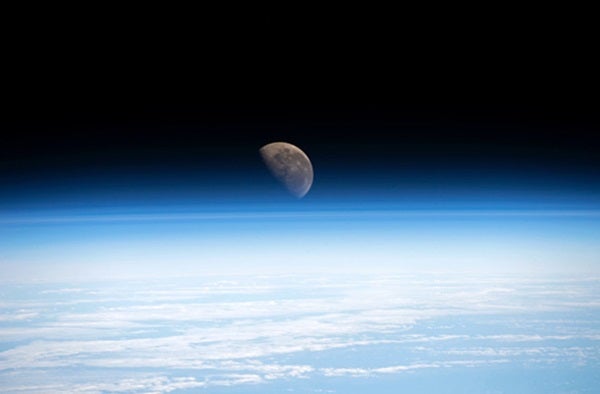
As moons go, ours is a good one. While the Moon only has a mass of around 1.2 percent that of the Earth, that’s huge compared to the other moons of the solar system. The Earth is also the largest of the rocky planets, so it’s natural to assume that bigger planets likely get bigger moons. But new research shows just how special our planet is: we’re big enough to get a big Moon, but small enough for it to be relatively large.
The Earth is the only rocky planet with a substantial moon. Mercury and Venus have nothing at all, and Mars only has two tiny captured asteroids to call its own. Large moons are much more prolific in the outer solar system. Two satellites, Ganymede and Titan, are even bigger than Mercury. But compared to their giant host planets they might as well not exist. For example, Ganymede weighs a whopping 10^20 tons … which is about 10,000 times smaller than Jupiter. The only decent ratio of parent to satellite is the Pluto-Charon system, where Charon weighs about 12 percent of Pluto.
The Moon has been essential to the successful evolution of life on Earth. Our large moon stabilizes our orbital tilt, keeping it to within the same few degrees over billions of years. This ensures that our seasons remain relatively unchanged over evolutionary timescales, allowing organisms to evolve and adapt without having to constantly deal with unpredictable climate systems. And our large moon has soaked up a lot of asteroid and comet impacts that would have hit the Earth instead.
Astronomers believe that we got our moon as a result of a giant impact. In this scenario, an object the size of Mars struck the still-molten proto-Earth in the early days of the solar system. This impact sent a ring of material up into orbit around the Earth. Much of that material rained back down onto the planet, but some stayed up, eventually coalescing to form our Moon.
That’s no moon
Giant impacts like this are relatively common during the formation of a solar system, where dozens, if not hundreds, of planetesimals jockey for position and resources in their quest for planethood. Larger planets are more likely to suffer more giant impacts, and so they should also have fractionally larger moons. But surveys of exoplanets have revealed no confirmed exomoons to date, despite the fact that almost all known exoplanets are larger than the Earth.
Where are the big moons? One proposal, offered by a team of researchers based at the University of Rochester and published in Nature Communications, suggests that Earth is in the sweet spot for forming giant moons. The reason: it’s all in the vapor.
When planetesimals collide, it’s not like two billiard balls cracking together. Instead, the enormous heat released by impact vaporizes a significant amount of the material. That cloud of debris, which is a mixture of vapor along with more solid remnants of any stuff kicked up from the impact, flings off into orbit around the planet.
With enough time that material will cool off, collect together, and form a moon. But the researchers discovered that vaporized material has a very difficult time coming together as a moon. That’s because some bits of vapor will quickly cool off to form droplets, but those droplets are immersed in a sea of still-hot vapor. The remaining vapor drags on the droplets, causing them to lose energy and forcing them to fall back down on the planet. Once there, they don’t get to participate in the process of building a moon.
Exomoon searches
This behavior of vapor droplets puts an upper limit on the ability for a planet to form a moon after a major impact. If the collision produces too much vapor, relative to solid remnants, then the resulting moon will be relatively small, because the moon can only form itself from coalescing solid remnants, and not the vaporized material.
Bigger planets are more likely to suffer bigger and badder impacts. Those impacts carry an enormous amount of energy and are therefore more likely to result in a more vapor-rich ring of material around the planet. So ironically, planets much larger than Earth are less likely to be able to form a substantial moon after a giant impact. On the other hand, planets smaller than the Earth won’t have very energetic impacts, meaning that the collision debris won’t be highly vaporized, but there won’t be a lot of material to begin with, so those small planets will have small moons.
The researchers found that Earth sits right at the edge of the sweet spot in a planet’s ability to form a large moon. Anything larger than about 1.6 Earth radii (corresponding to about 60 percent greater than Earth’s mass) is the cutoff point for forming large moons. This explains why we haven’t discovered any exomoons so far in our searches outside the solar system. Our current surveys are biased towards larger planets, but they are unlikely to have correspondingly large (and easily detectable) moons.









